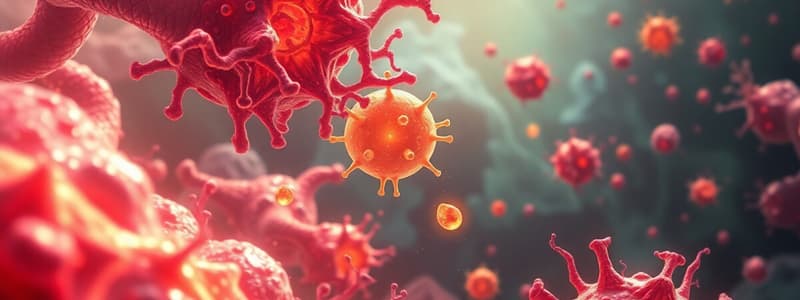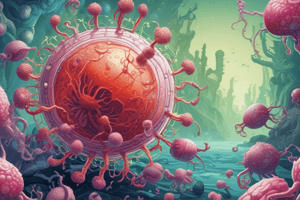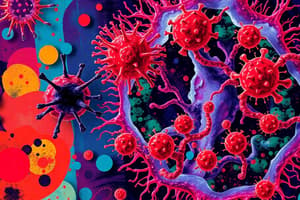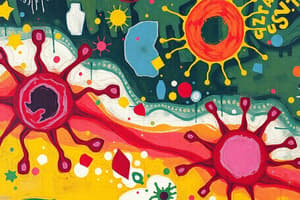Podcast
Questions and Answers
What role do adhesins play in the context of virulence factors?
What role do adhesins play in the context of virulence factors?
Which of the following correctly describes endotoxins?
Which of the following correctly describes endotoxins?
Which type of toxin primarily causes paralysis by inhibiting neurotransmitter release?
Which type of toxin primarily causes paralysis by inhibiting neurotransmitter release?
What characteristic differentiates exotoxins from endotoxins?
What characteristic differentiates exotoxins from endotoxins?
Signup and view all the answers
Which of the following best describes superantigens?
Which of the following best describes superantigens?
Signup and view all the answers
Which factor is responsible for breaking down host tissues to promote pathogen invasion?
Which factor is responsible for breaking down host tissues to promote pathogen invasion?
Signup and view all the answers
What kind of toxins are known to form pores in host cell membranes?
What kind of toxins are known to form pores in host cell membranes?
Signup and view all the answers
Which of the following is a specific effect of cholera toxin?
Which of the following is a specific effect of cholera toxin?
Signup and view all the answers
Study Notes
Virulence Factors
- Virulence factors are molecules produced by pathogens to facilitate infection, tissue damage, and immune avoidance.
- Examples include adhesins (attach to host cells), exoenzymes (break down tissues), and toxins (damage cells).
- Exotoxins, like cholera toxin, disrupt cellular functions, while endotoxins, found in Gram-negative bacteria, trigger inflammation, fever, and shock.
Endotoxins vs. Exotoxins
- Endotoxins are heat-stable components of Gram-negative bacteria (Lipid A).
- They trigger general inflammatory responses, potentially leading to septic shock at high concentrations.
- Exotoxins are proteins, mostly from Gram-positive bacteria, but also some Gram-negative ones.
- They target specific cells and tissues, causing precise damage through specific mechanisms, like inhibiting neurotransmitter release.
- Exotoxins are heat-labile and highly potent.
Types of Exotoxins
- Intracellular-targeting toxins (A-B toxins): These toxins enter cells and interfere with specific cellular functions. Examples include diphtheria (inhibiting protein synthesis), and botulinum toxin (inhibiting neurotransmitter release).
- Membrane-disrupting toxins: These toxins damage host cell membranes by creating pores or degrading lipids. An example is streptolysin.
- Superantigens: These exotoxins overactivate the immune system by stimulating a large number of T-cells, leading to a cytokine storm. An example is toxic shock syndrome toxin (TSST).
Viral Adhesion and Antigenic Variation
- Adhesion: Viruses use specific viral proteins (adhesins) to bind to host cell receptors.
- Example: Influenza virus binds to sialic acid on respiratory cells, and HIV to CD4 and co-receptors.
- Antigenic Variation: This mechanism allows viruses to evade the immune system.
- Antigenic drift: Small mutations in viral proteins, evolving strains.
- Antigenic shift: Reassortment of viral genes leading to completely new strains (like influenza).
Studying That Suits You
Use AI to generate personalized quizzes and flashcards to suit your learning preferences.
Related Documents
Description
Explore the essential concepts of virulence factors and their role in pathogenicity. This quiz covers the differences between endotoxins and exotoxins, including examples and mechanisms of action. Test your knowledge on how these factors contribute to infection and disease.




